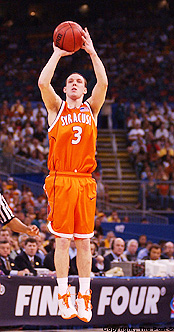The Orange are improving, which provides me with some sense of relief. It seemed early in the season that the team was never going to improve. The 49th consecutive win against Colgate came rather easily, and with this team, prior to tip off, it may not have been easy. But there was nothing to worry about.
Trevor Cooney has gotten his game back on track and continues to keep himself involved in the offense as a playmaker, not just a shooter. That type of play can only continue to help the Orange as the season progresses. It will take pressure off of Kaleb Joseph, help open up the middle of the court, and force defenders to guard Cooney honestly.
Rakeem Christmas has proven himself to be a strong inside presence this year both offensively and defensively. The key will be how many minutes can he stay on the court without getting into foul trouble.
The sophomore class continues to be inconsistent, but bright spots due appear. Ron Patterson had his opportunity to shine with a nice game against Colgate (13 pts on 3-6 three point shooting). Proper perspective would remind you that it was against Colgate; however, Patterson has done very little recently and has been a healthy non-play in some of those games. So it was nice to see him get some quality time.
Chris McCullough seems to be regressing. He can definitely rebound but offensively he is really struggling, and defensively he isn't always in the right position.
The team is improving, and it will be interesting to see how much better they can get.
I am more concerned with the defense than the offense right now. The bright side is that Jim Boeheim has found the team does reasonably well with their press defense, so there is a defensive scheme that works. The dark side is that they team is struggling with its bread-and-butter zone defense. It seems to me that there is poor backside rotation covering the holes, and the wings are still slow at getting out on the shooters. I am not sure that is something that can be fixed quickly in the season. It can improve, but the key to a zone defense is everyone moving as one, and not allowing gaps to occur. It is a very difficult defensive concept, one that takes time, and I think having only two returning starters is hampering that development.
It is good however to be going into the Christmas holiday with a recent victory.
Go Orange!






